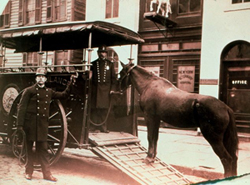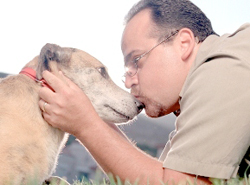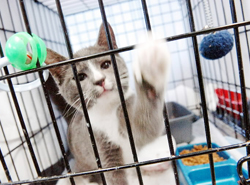

"If every animal shelter in the United States embraced the No Kill philosophy and the programs and services that make it a reality, we would save over four million dogs and cats who are scheduled to die in shelters this year and the year after that. It is not an impossible dream."
-- No Kill Advocacy Center
-- No Kill Advocacy Center

The Henry Bergh Story
In 1866 a man named Henry Bergh started the first animal shelter in America by creating the SPCA in New York City.
Bergh had experienced an epiphany of sorts when he was traveling through Russia. He saw a man beating his horse and made him stop. The good feelings generated by this act stayed with Bergh and made him decide that this was his life mission - preventing cruelty to animals. The New York that Bergh returned to was not a nice place for animals. Horses were forced to drag overloaded vehicles and were regularly beaten as they struggled. They often dropped dead in their traces. Animal control consisted of bands of roving hoolligans who searched for loose dogs that they would take to the pound for $.50
a dog. If they could not find free roaming victims, they would rip dogs from the arms of their owners. The pound was a place of horrors were dogs were thrown together in one space with no regard for temperament, health needs or sex. They received no food or water. The people responsible did not try to make improvements - they firmly believed that there was no other way. Henry Bergh felt otherwise.
In February of 1866 he gave the first speech on animal protection in the United States. He called for a moral fight to help the animals. Nine days later, the state passed a law prohibiting cruelty to animals and Bergh's fledgling ASPCA was given the power to enforce that law. Bergh spent the next 20 years fighting animal cruelty in person wherever he encountered it. With top hat and cane, he confronted drivers of overloaded carts and busses drawn by horses and forced them to unload. Once he tossed a recalcitrant driver into a snow bank and unhitched his horses himself.
He refused to take over the animal control function for the city. He felt that the ASPCA should be a force to champion and protect life, not to end it. He understood that animal welfare and animal control were two seperate entities. Those involved in animal protection should not be involved in killing.
What a concept! Those who care for animals and protect them should not be killing them. This was the principle upon which the naceant movement of animal protection was built. How did we go so wrong? How did animal shelters become places where animals go to die? This process is explained in facinating detail by Nathan Winograd in his newly published book, "Redemption." Winograd, the foremost proponent of the no kill movement in America, shows in a cogent and eminently readable book, how the movement went wrong - and how it can go right.
Fast forward to 1976. Richard Avanzino takes over control of the San Francisco SPCA. At this time, the SPCA was a killing shelter. Instead of continuing business as usual, Avanzino began to make changes. He pioneered the use of foster homes, increased the use of volunteers, started a spay/nueter program for the community and, ultimately, walked away from a $1.8 million contract with the city. Avanzino would not be killing homeless animals anymore. And the no kill movement was born. City animals found as strays would go to a new city pound, but the SPCA would take all those not claimed after 10 days. The residents of the city supported the movement to save lives. A new state of the art shelter was built. San Francisco became the first no kill city in the nation.
Instead of rejoicing and instituting these programs in their towns, those entrenched in the process of killing, the naysayers, insisted that this only happened in San Fransisco because it is a wealthy city with a large gay population - gay people love animals - but this could never happen in a rural area.

Nathan Winograd
In 2001, Nathan Winograd, former director of operations at the S.F.SPCA, loaded his wife, 2 children, 2 dogs and 20 mostly feral cats into an RV and began the 3000 mile drive to Tompkins County in rural upstate New York. He had been hired as executive director of the Tompkins Co. SPCA. When he arrived he found, "a filthy shelter where animals were standing in their own waste, employees were rude and disrespectful, and sick kittens in what they called, the "isolation room", were hovering around empty water bowls and getting substandard care." It also had a high killing rate. Winograd immediately did three things: stop the killing; stop the killing; stop the killing. He did not tolerate the old excuses. He fired staff that did not accept new life saving programs that had worked in San Francisco. Overnight he turned a high kill shelter in an old inadequate building in a remote corner of rural upstate New York into a no kill facility that, three years later, was housed in a brand new state of the art shelter. Once again, the community rallied behind the new approach that met their needs and helped them to do the right thing.
Once again, instead of rejoicing and instituting these programs and policies, the nay sayers insisted that this might be possible in a rural shelter in a northern state, but this would never work in a southern area. This is due to the "Bubba Factor" - a demeaning and degrading term used to sum up the supposed ignorance and insensitivity of, apparently, everyone living south of the Mason/Dixon line. But then, they began a no kill program in Charlotteville, Va. And it's working.
In the meantime. Winograd had left Tompkins County in order to pursue the life of consultant on the no kill movement nationwide. He was called into the city of Philadelphia to reform the Philadelphia Animal Contol Authority, reportedly one of the worst in the country. This facility was housed in a terrible location, staffed with uncaring and burned out workers and was killing 22,000 animals a year. Critical to the new efforts was the hiring of a new director, committed to the no kill philosophy. Just seven months after the new director was hired, PACCA's new leadership team reported: "We reached a tremendous milestone in saving more than half the animals that we admitted. In all of its' history, PACCA had never achieved this level of lfe saving. . . Even more amazing than this, in a facility that accepted 756 cats in the month of January, we did not kill a single cat simply to make space. Once again, that is a milestone that had never been achieved."
There is no question that no kill is an attainable goal everywhere. It certainly is in our community. The only thing which keeps animals dying is ignorance and lack of initiative on the part of the killers - those who manage the killing facility. No matter how they try to explain it away, no matter what excuses they put forward, killing healthy, adoptable or treatable animals is morally and ethically reprehensible.
As Henry Bergh proposed over 100 years ago, it is the job of the people who are charged with animal protection to protect animals. Killing them is not protecting them. In our community there is only one killing shelter, Lehigh County Humane Society. We say to them, if you can't do the job you should be doing, get new people in there who can.

Local Success Story
It is not enough to just take animals in and try to find them homes. This extremely limited approach has been used since sheltering began. It has not solved the problem. Killing animals deemed "hard to place" because they are too old or too young or too shy or not pretty enough has not solved the problem. Trapping feral cats and then killing them because they are "not adoptable" has not solved the problem. Providing shelter for a few forever and closing the door on the rest has not solved the problem. Lack of cooperation and coordination among the various groups has certainly not solved the problem. And yet, these situations continue to exist while innocent animals die. Isn't it time for a change?
The Northampton County SPCA ( now the Center for Animal Health and Welfare) thought it was when the shelter went no kill in 2003. To make this happen the administration worked hard to greatly enlarge the foster home program, engage with more rescues, expedite the adoption process by taking animals off site and offering special incentives and, most importantly, by instituting a dynamic and aggressive spay/neuter program. There were plenty of people who insisted that none of this would work and the Center faces difficult problems every day. But they have a commitment to honor . That is that every animal who comes to them is important and deserves every chance to find a forever home. It can be done. They have done it.
What Does No Kill Mean?
- Animals in shelters are given every opportunity to find good permanent homes.
- No animal is ever killed just to "make room."
- No animal is killed because it is "difficult to adopt."
- More than just a phrase, it is a call to action through the implementation of life saving programs.
- It does not mean that animals are never killed. Euthanasia (in the true sense of the word) is practised when it is the only humane alternative. This occurs only when an animal is too sick or injured to be helped by reasonable medical care. Or, when an animal is a bona fide danger to people or other animals.
Website Design by: Clarissa Agiato, Kenny Singh, Jean Witinski © 2014
